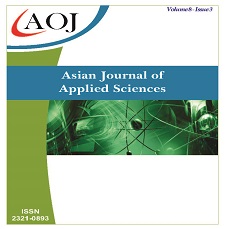The Statistical Distributions of PM2.5 in Rayong and Chonburi Provinces, Thailand
DOI:
https://doi.org/10.24203/ajas.v8i3.6153Keywords:
PM2.5, Statistical distribution, Chonburi Province, Rayong ProvinceAbstract
The fine particulate matter (PM2.5) concentrations is one of the most important issues that are often discussed since it has a greater impact on human health. Statistical distribution modeling plays an important role in predicting PM2.5 concentrations. This research aims to find the optimum statistical distribution model of PM2.5 in Rayong Province and Chonburi Province. The daily average data from 2014 – 2019 for Rayong and from 2015 – 2019 for Chonburi were using. Five statistical distributions were compared. A proper statistical distribution that represents PM2.5 concentrations has been chosen based on three criteria include Anderson-Darling statistic and RMSE. The results show that Pearson type VI distribution performs better compared to other distributions for PM2.5 concentrations in Rayong. For Chonburi, the proper statistical distribution is Log normal distribution.
References
[2] El-Shanshoury, Gh. I., “Fitting the Probability Distribution Functions to Model Particulate Matter Concentrationsâ€, Arab Journal of Nuclear Sciences and Applications, vol.50, no. 2, pp. 108-122, 2017.
[3] Forbes, C., Evans, M., Hastings, N. and Peacock, B., Statistical Distributions, 4th ed., Wiley, New York, 2011.
[4] Gavriil, I., Grivas, G., Kassomenos, P., Chaloulakou, A. and Spyrellis, N., “An application of theoretical probability distributions, to the study of PM10 and PM2.5 time series in Athens, Greeceâ€, GlobalNEST International Journal. 8. 241-251. 2006.
[5] Kan, H. D. and Chen, B. H., “Statistical Distributions of Ambient Air Pollutants in Shanghai, Chinaâ€, Biomedical and Environmental Sciences, vol. 17, pp. 366-372, 2004.
[6] Limpaseni, W. “The Harmful Effects of PM2.5â€, Thailand Engineering Journal, vol. 71 no. 1, pp. 9-17, 2018. (In Thai)
[7] Lu, H. C., Fang, G. C. and Wu Y. S., “Estimating the Frequency Distributions of Particulate Matter and Their Metal Elements in a Templeâ€, Journal of the Air & Waste Management Association, vol. 56, no. 7, pp. 1033-1040, 2006.
[8] Pobocikova, I., Sedliackova, Z. and Michalkova, M., “Application of Four Probability Distributions for Wind Speed Modelingâ€, Procedia Engineering, vol. 192, pp. 713-718, 2017.
[9] Rossita M. Y. and Masud M. H., “Predicting Hourly PM10 Concentration in Seberang Perai and Petaling Jaya Using Log-Normal Linear Modelâ€, International Journal of Management and Applied Science (IJMAS), vol. 3, no. 3, pp. 103-108, 2017.
[10] Wang, X., Chen, R. J., Chen, B. H. and Kan, H. D., “Application of Statistical Distribution of PM10 Concentration in Air Quality Management in 5 Representative Cities of Chinaâ€, vol. 26, no. 8, pp. 638-646, 2013.
Downloads
Published
Issue
Section
License
Copyright (c) 2020 Vanida Pongsakchat, Pattaraporn Kidpholjaroen

This work is licensed under a Creative Commons Attribution-NonCommercial 4.0 International License.
- Papers must be submitted on the understanding that they have not been published elsewhere (except in the form of an abstract or as part of a published lecture, review, or thesis) and are not currently under consideration by another journal published by any other publisher.
- It is also the authors responsibility to ensure that the articles emanating from a particular source are submitted with the necessary approval.
- The authors warrant that the paper is original and that he/she is the author of the paper, except for material that is clearly identified as to its original source, with permission notices from the copyright owners where required.
- The authors ensure that all the references carefully and they are accurate in the text as well as in the list of references (and vice versa).
- Authors retain copyright and grant the journal right of first publication with the work simultaneously licensed under a Attribution-NonCommercial 4.0 International that allows others to share the work with an acknowledgement of the work's authorship and initial publication in this journal.
- Authors are able to enter into separate, additional contractual arrangements for the non-exclusive distribution of the journal's published version of the work (e.g., post it to an institutional repository or publish it in a book), with an acknowledgement of its initial publication in this journal.
- Authors are permitted and encouraged to post their work online (e.g., in institutional repositories or on their website) prior to and during the submission process, as it can lead to productive exchanges, as well as earlier and greater citation of published work (See The Effect of Open Access).
- The journal/publisher is not responsible for subsequent uses of the work. It is the author's responsibility to bring an infringement action if so desired by the author.


